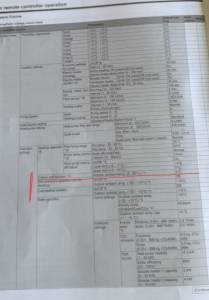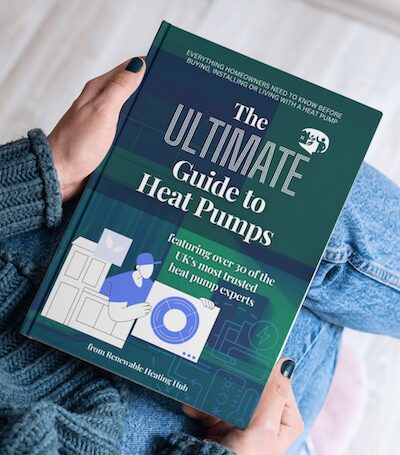Posted by: @cathoderayPosted by: @amanda1but if the coils freeze up then it won’t be able to run
But isn't that what defrost cycles are for, which are not the same thing as a freeze stat (which from what others have said, kicks in when the circulating water rather than the coils get below a certain temperature)? My confusion is that the primary purpose of a freeze stat is to protect the system when it is off, and in winter/cold weather the only likely reason for the system to be off is a power cut, which means the freeze stat can't do its thing. I can't help wondering if Mitsubishi are peddling a pointless marketing gimmick.
I am sure you have already researched this, but might other countries with cold climates and significant snow build up and high levels of heat pump installations (Scandinavian countries? Canada?) have found ways of managing the snow?
Posted by: @amanda1Mitsubishi claim that the Ecodan is particularly good in cold weather, down to -20
The same sales people will tell you that their breed of pigs are good at flying, particularly in cold weather with icing conditions.
My heating is off (on standby, not powered down) overnight and I'll not be the only one to do this. I also like to go away to warmer places in the winter or away for a day or 2. I suppose holiday setting does a similar thing but you have to remember to set that and it works in multiples of days only. Mitsubishi don't really peddle Freeze Stat; in fact they are quite evasive about saying what it actually does.
If you believe the data book (and I'd be surprised if Mitsubishi made the data up) then Ecodans actually deliver their badged power down to realistic low ambients and flows degrees and can deliver more at milder temperatures. In other words an 8.5kW Ecodan would be a 10kW Midea.
Posted by: @cathoderayPosted by: @amanda1but if the coils freeze up then it won’t be able to run
But isn't that what defrost cycles are for, which are not the same thing as a freeze stat (which from what others have said, kicks in when the circulating water rather than the coils get below a certain temperature)? My confusion is that the primary purpose of a freeze stat is to protect the system when it is off, and in winter/cold weather the only likely reason for the system to be off is a power cut, which means the freeze stat can't do its thing. I can't help wondering if Mitsubishi are peddling a pointless marketing gimmick.
I am sure you have already researched this, but might other countries with cold climates and significant snow build up and high levels of heat pump installations (Scandinavian countries? Canada?) have found ways of managing the snow?
Posted by: @amanda1Mitsubishi claim that the Ecodan is particularly good in cold weather, down to -20
The same sales people will tell you that their breed of pigs are good at flying, particularly in cold weather with icing conditions.
My heating is off (on standby, not powered down) overnight and I'll not be the only one to do this. I also like to go away to warmer places in the winter or away for a day or 2. I suppose holiday setting does a similar thing but you have to remember to set that and it works in multiples of days only. Mitsubishi don't really peddle Freeze Stat; in fact they are quite evasive about saying what it actually does.
If you believe the data book (and I'd be surprised if Mitsubishi made the data up) then Ecodans actually deliver their badged power down to realistic low ambients and flows degrees and can deliver more at milder temperatures. In other words an 8.5kW Ecodan would be a 10kW Midea.
Posted by: @cathoderayI am probably the only one, but I find all this stuff about freeze stats confusing. In normal but cold conditions, surely a heat pump will be running all the time, because that is how they are designed to work, meaning the circulating water is always comfortably above freezing temperatures, making a freeze stat redundant. The only time when freezing is a real risk is during a power cut, at which point a freeze stat is useless, because there is no power. Frost protection then has to be achieved in other ways, eg antifreeze solution or antifreeze valves. Perhaps someone can enlighten me...
here's a use case: I've seen the "freeze protection mode" on my (samsung) kick in during a very cold snap night in april, after a mild day. the heating didn't run much during the day (and when it did, at a lower LWT due to Weathercomp), and due to setback was effectively off overnight, so the system water was not particularly hot to start the night. by 0400 both the ambient temp (went down to just about +0.5C ) and the HP's water temp were low enough to reach the point that the system decided "I need to run to protect myself". which it did. it does this whether or not there is glycol in the system (mine doesn't have glycol). My understanding is that the main reason for this behaviour are that compressors can struggle to restart with water temps lower than something in the 15ish range, so they start them up at that point rather than waiting till it gets close to zero.
there is then a separate (but similarly named) piece of system design which is "freeze AND power loss" protection. i.e. what do do if you've no power and the system is going to freeze due to not being able to run and obviously wreck itself. The approaches for that are either glycol or antifreeze valves to empty the water out of the outside part of the wet circuit (to protect against the freeze part), or a battery to protect against the power loss part.
if the system is running to heat the house then the "freeze protection mode" should be nothing to do with what may be happening to the HP.
My octopus signup link https://share.octopus.energy/ebony-deer-230
210m2 house, Samsung 16kw Gen6 ASHP Self installed: Single circulation loop , PWM modulating pump.
My public ASHP stats: https://heatpumpmonitor.org/system/view?id=45
11.9kWp of PV
41kWh of Battery storage (3x Powerwall 2)
2x BEVs
@cathoderay no, they are the same thing. Except, it works when the pump is switched on whether running or in standby. The freeze statsetting is what sets the temperature that the defrost cycles kicks in at. It isn’t just for when the pump is off, it is for when the pump/the coils/the primary water supply might freeze up whether or not the pump is on or off. When the freeze stat is set at 3, the defrost cycle will kick in when the ambient temperature drops to 3. The defrost cycle reverses the heat put out by the pump to heat the coils and prevent the pump from icing up. Meanwhile it uses the immersion heater to heat the house if heat is being called for. This is why some people are finding that their ASHP consumption is a nightmare in freezing temperatures. If you have sufficient glycol in the system, you can switch off the freeze stat.
There is also a defrost setting which keeps the house above a certain temperature if you are away. This is different from the Freeze Stat/defrost cycle.
This is what I have gleaned so far, from several sites.
Re snow. It’s quite hard to find much online about how people deal with these temperatures in Scandinavia, because Google likes to keep us in our national boxes, but I did find a useful research paper on COP achieved by ASHPs in Norway. But I imagine they have the same problem with snow accumulation in gardens and on rooftops that we have here.
@iancalderbank OK my knowledge of it so far is based on what it says in the manual: see screenshot.
Where the * is, note 11 says that if you set it to * then there is a risk of the primary water supply freezing. Unless you have Glycol in the system. If you have sufficient Glycol, you don’t need the Freeze Stat setting. You can set the Freeze Stat to on whether or not you have Glycol. But to set it to off, you need to have Glycol. But if you have the Freeze Stat setting, the defrost cycle is going to be running a lot if you have an ambient temperature that is constantly below 3 degrees.
A Heating Engineer is coming out today to check the Glycol levels in my system and I will be asking him to explain both these functions to me (although I prefer to see printed explanations!).
in general there are a few concepts to try to separate and think about
"defrost" = the heat pump running in reverse. to defrost itself when its iced up, happens regularly when HP working hard in cold conditions. usually sends cold water to the CH circuit whilst doing this.
"back up heater" = the heat pump switching on a resistance heater in the CH circuit to supply heat to the house. possibly at the same time as defrost (to alleviate the aforementioned cold CH water when in that mode) or possibly just as an additional "boost". If this is on a lot, then the system will cost a lot to run because of the inefficiency of resistance heating vs HP. This could perhaps have been your neighbours cost issue.
"freeze protection mode" = the heat pump switching itself on in "normal" mode to stop itself cooling down to much when its not running, and there is no other input telling it to run. this is not "defrost" mode.
"freeze and power loss protection" = the design of the system to cope with both of these happening at the same time.
its not quite clear to me which of these you are getting and what the specific setting you are tweaking deals with. that needs someone who knows the exact behaviour of the mitsubishi 1st hand which I don't.
My octopus signup link https://share.octopus.energy/ebony-deer-230
210m2 house, Samsung 16kw Gen6 ASHP Self installed: Single circulation loop , PWM modulating pump.
My public ASHP stats: https://heatpumpmonitor.org/system/view?id=45
11.9kWp of PV
41kWh of Battery storage (3x Powerwall 2)
2x BEVs
@iancalderbank “defrost” = triggered by the Freeze Stat setting. Does exactly what you described, and it kicks in at 3 degrees if you have it set to on. Which is the problem my neighbour had. Frequent running won’t be a problem if you don’t often have temperatures that low.
I think your “freeze protection mode” might be the same thing as “Cold Weather Function” in my Mitsubishi manual. I will clarify this this afternoon!
Posted by: @amanda1It’s quite hard to find much online about how people deal with these temperatures in Scandinavia, because Google likes to keep us in our national boxes
See my rant here!
Midea 14kW (for now...) ASHP heating both building and DHW
@cathoderay Well that solves the issue of where the extra heat is going, its being used at night 🙂 I think your house is so thermally leaky, that all the efficiency savings are being lost overnight. I have an old house too and am trying to give the walls some insulation without tanking them. Im having a go using insulated lime plaster. Too early yet to give feedback though.
House-2 bed partial stone bungalow, 5kW Samsung Gen 6 ASHP (Self install)
6.9 kWp of PV
5kWh DC coupled battery
Blog: https://thegreeningofrosecottage.weebly.com/
Heatpump Stats: http://heatpumpmonitor.org/system/view?id=60
Posted by: @bontwoodyIm having a go using insulated lime plaster. Too early yet to give feedback though.
It'll be very interesting to hear any feedback once you have it. One of the problems I have is the rooms are already small, adding extra internal thickness to the walls is not something I am in a rush to do. It will also be very disruptive, eg the 'leakiest' room is probably my kitchen, with three external walls, but much of the wall is covered with a fitted kitchen. I try to persuade myself that a fitted kitchen cabinet must of itself provide some insulation...
Midea 14kW (for now...) ASHP heating both building and DHW
@amanda1 from what I can see (From a quick read of their manuals), the mitsubishi "freeze stat" configuration is a form of "freeze protection function" as I described it. A defrost is a different thing entirely and it would make no sense to stop the heat pump being able to do a defrost at any particular temperature. also as far as I can tell from that read, the "cold weather function" enables the use of a booster / backup heater i.e. electrical resistance. there are other fora where the mitsubishi settings are discussed in great depth those may give you a better understanding of your specific device- you can also look on "community.openenergymonitor.org" and "forum.buildhub.org.uk". (and/or I see you've asked on here separately).
My octopus signup link https://share.octopus.energy/ebony-deer-230
210m2 house, Samsung 16kw Gen6 ASHP Self installed: Single circulation loop , PWM modulating pump.
My public ASHP stats: https://heatpumpmonitor.org/system/view?id=45
11.9kWp of PV
41kWh of Battery storage (3x Powerwall 2)
2x BEVs
Posted by: @cathoderayI try to persuade myself that a fitted kitchen cabinet must of itself provide some insulation...
It does if you place Actis Super 10+ (or equivalent) behind the cabinet.
Building Regs surveyors differ in their ideas about multi-foil insulation. When I did a large extension a decade ago, I was permitted to use multi-foil for 50% of the required insulation levels.
But it doesn't apply in your case because re-fitting kitchen cupboards doesn't invoke Building Regs anyway!
Save energy... recycle electrons!
- 26 Forums
- 2,356 Topics
- 53.4 K Posts
- 370 Online
- 6,017 Members
Join Us!
Worth Watching
Latest Posts
-
RE: Octopus Cosy Heat Pump Owners & Discussion Thread
@andrewj Seeing they deleted both threads with the pict...
By HarrisonC , 7 hours ago
-
RE: Who's your electricity provider and what's your tariff?
@mars I think your commentary is very fair and balanc...
By JamesPa , 7 hours ago
-

RE: External pipework insulation
That's great advice @transparent... thank you. @david...
By Mars , 8 hours ago
-
RE: Advice on internal circulation pump noise
Thanks @mikefl - I'll maybe have a look at the lock-shi...
By jtg , 9 hours ago
-

RE: Heat Pump Heats the House… But It’s Not Cosy. Emitter Changes or System Tweak?
@toodles interesting suggestion, thanks. I will try to...
By GrahamF , 9 hours ago
-
RE: Mitsubishi Ecodan Auto Adaption trial to stop cycling.
The interval you talk of, i think, will be 60min for an...
By F1p , 13 hours ago
-

RE: Electricity price predictions
Does anyone have a current graphic, visual or breakdown...
By Mars , 16 hours ago
-
Agree with @majordennisbloodnok on the setbacks. We hav...
By ChandyKris , 1 day ago
-
RE: New Fogstar 15.5kWh upright solution
It is a matter of luck. 2ith Fogstar "instructions", to...
By Batpred , 1 day ago
-

RE: Speedcomfort radiator fans
@deltona the way the links were added broke the page. A...
By Mars , 1 day ago
-

RE: Setback savings - fact or fiction?
I agree! Even more so if we get an answer! But the chal...
By cathodeRay , 1 day ago
-

RE: Refrigerant R32, is it now banned in the EU from 1st Jan 2027 for monobloc ASHPs?
This has been delayed from what I believe to be this ye...
By dgclimatecontrol , 2 days ago
-
RE: Are We Sleepwalking Into Another Race to the Bottom?
this is why I provided current flow temperatures in the...
By ksim , 2 days ago
-

RE: Why Millions of UK Homes Struggle With Heat Pumps
There's many homes that would be quite a disruption for...
By dgclimatecontrol , 2 days ago
-
RE: Ecodan unable to hit legionella target temp - what's the consensus?
@rhh2348 ...maybe this option is what you want? Alter...
By benson , 2 days ago
-

RE: Free Ecoheat Heat Pump Install
@old_scientist This does make the unit smaller as the b...
By dgclimatecontrol , 2 days ago
-
RE: Ecodan - Legionella Operation Time and Target Temperature
@old_scientist hiya mate, did you ever get to the botto...
By 9jwr9 , 2 days ago
-
RE: Configuring third party dongle for Ecodan local control
@majordennisbloodnok I think the HPDHD diagnosis may be...
By Sheriff Fatman , 2 days ago





